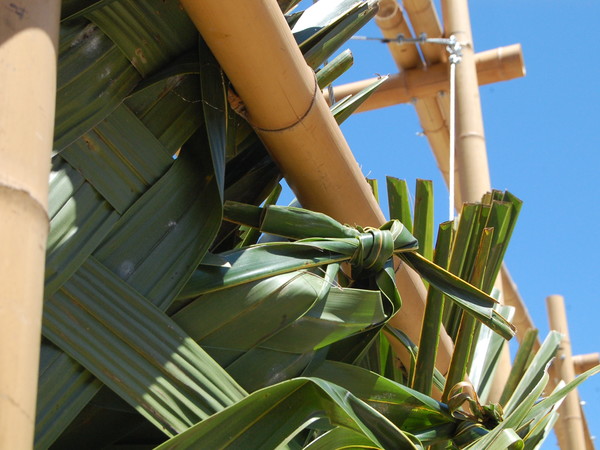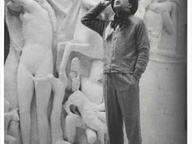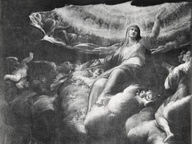Vegetation as a political agent

Emory Douglas, Wall painting, 2014, cm 252x17
From 30 Maggio 2014 to 02 Novembre 2014
Turin
Place: PAV - Parco Arte Vivente
Address: via Giordano Bruno 31
Responsibles: Marco Scotini
Telefono per informazioni: +39 011 3182235
E-Mail info: luisa.cicero@comune.torino.it
Official site: http://www.parcoartevivente.it
Friday, May 30th , at 18.30, under the artistic program Commons Art in 2014 and with the support of the Compagnia di San Paolo, the PAV opens Vegetation as a political agent, group exhibition curated by Marco Scotini.
The exhibition aims to investigate the social and historical implications of the plant world in the light of the increasingly common claim of "green" as an agent of change in the economic processes and the current crisis. Attributed to a plant, means to analyze the historical plant element not only in its biological component, but also in relation to the social and political aspects that they see it already in the middle of the first forms of economic globalization. In the seventeenth and eighteenth centuries, through colonial plantations and markets by sea, it is in fact defined the first systems to control the species and taking shape conditions of exploitation and expropriation of land in the struggle for the monopoly of the spice. Within this history, the exhibition aims to highlight those stages wherein the plant has been a sign of social emancipation.
Divided on the double register of history and current events , Vegetation as a political agent puts together, and on the same floor , architectural and artistic works of thirteen international artists documents pioneering figures of the first revolutions ecological and scientific equipment from the botanical world . Together with the works and installations, the exhibition includes a wide range of illustrations and plant samples , archival materials and posters produced in a wide variety of different cultural contexts. The geopolitics that is the background goes from the Indian Ocean ( Mauritius and Réunion) to Guinea- Bissau, from South Africa to Mexican territory.
The historical section of the exhibition and documentary comes from consulting with the Herbarium of the University of Turin in collaboration with Prof. Rosanna Piervittori and the Botanical Garden of Turin, which, thanks to the scientific supervision of the former Director Rosanna Caramiello , has allowed the identification of some species foothill protected and endangered exposed in the greenhouse of the PAV ( Peony and Marsilea, among others) . Next to the tables of the herbaria taken from volumes of Carlo Ludovico Allioni ( who was the director of the Botanical Garden at the Castello del Valentino in the second half of the eighteenth century and in close contact with Linnaeus to the definition of systems of classification ) are shown pictures, posters and extracts from texts that underscore the possible narratives of the plant world in terms of regulation , the conservative and the use of medicinal plants such as China and Coke.
Inside and outside the PAV also investigated the relationship between agriculture and the popular movements in the documents relating to the figure of Amilcar Cabral , an agronomist and politician who led guineense Guinea- Bissau and the Cape Verde Islands independence from Portugal; the ecological role of activism are explored through the figure of Mel King in the draft NomedaeGediminas Urbonas, the murals of EmoryDouglas, one of the leaders of the Black Power movement in defense of the American rural proletariat , and protest camps in the United Kingdom investigated by treesitting Adelita Husni -Bey . The revolutionary model for the recycling of waste proposed by the pioneer George Chan is at the center of the search for FernandoGarcía - Dory . Last but not least , are presented forms of expression and collective imaginations on the issues of the green revolution made ??manifest in forms and costumes designed by Piero Gilardi and worn in theater animations against the use of GMOs in crops of maize ( GMO Free , 2014 ).
In the court of the PAV take shape two environmental installation created for the exhibition by the groups Rozo (Philippe Zourgane & Séverine Roussel ) and Critical Art Ensemble. Rozo debug Salle concerns, vernacular architecture type that becomes a viable plant shelter made ??of bamboo and palm leaves ( woven on the spot by a farmer of the islands of Réunion). The installation hosts a series of video documentation on the former French colonies of Vietnam, Algeria and the islands of Réunion. At the end of the court, the American collective Critical Art Ensemble creates rather sterile field. This is a portion of land, partly made ??from a strip of grassy layer of the park PAV and made available for the operation, the method worked with roundup ready , chemical process of weeding invasive , long- lasting, destroys biodiversity.
In relation to the plant world , Vegetation as a political agent finally raises some questions about the claim of subjectivity through creative practices ortocoltutra , as in the research and experimentation of artists AyreenAnastas & Rene Gabri with the marketing of organic seeds for the re - balance of the soil; Claire Pentecost with the investigation of transgenic maize in Mexico ; MarjeticaPotr? who engaged in participatory community projects , has given life to the vegetable self-organized the Ubuntu Community Park in a neighborhood - village of Soweto in South Africa (2014) . Figures such as the Hungarian Imre Bukta and the Californian Now Bonnie Sherk are finally witnessing the 70s pioneering forms of the relationship between art and agriculture under the opposite polarity of the Cold War.
As part of the exhibition, and the Educational Activities Educational PAV present to the public a series of workshops, the timetable will be published on the site www.parcoartevivente.it , conducted by the artists in person. Beginning with Daniel Halter , involved with Marjetica Potr? in Nine Urban Biotopes common international project , the program will see the South African artist , engaged in a residence in Turin ( Mirafiori south), in a collective of urban gardening. The Slovenian Potr?, however , will bring the results of the project plan made ??with the Community School Design for the Living World of Soweto. Later, Ayreen Anastas & Rene Gabri will be at the PAV persperimentare their research concerning the collection and dissemination of seeds, essential good now at risk because of global monopoly held by a small group of companies.
Regarding the workshops for families, Sunday, June 15 ( 15-17 hours ) the review involves laboratory WORKSHOP SUNDAY = New Alliances , the method developed by the Critical Art Ensemble, practical alliance between the citizens and the plant species in absolute protection , which continues today with the collaboration of the Botanical Garden of Turin.
Summer camps for schools and the themes of the exhibition will be detailed in Herbarium minimum experience of collecting and cataloging of botanical species, cultivated and pioneer, chosen from among the varieties in the park.
Artists :
Ayreen Anastas & Rene Gabri , Imre Bukta , Amilcar Cabral, Filipa César , Critical Art Ensemble , Emory Douglas, Fernando García- Dory , Piero Gilardi , Daniel Halter , Adelita Husni -Bey , Now Bonnie Sherk , Claire Pentecost , Marjetica Potr? , Rozo ( Philippe Zourgane & Séverine Roussel ) , Nomeda and Gediminas Urbonas
The exhibition aims to investigate the social and historical implications of the plant world in the light of the increasingly common claim of "green" as an agent of change in the economic processes and the current crisis. Attributed to a plant, means to analyze the historical plant element not only in its biological component, but also in relation to the social and political aspects that they see it already in the middle of the first forms of economic globalization. In the seventeenth and eighteenth centuries, through colonial plantations and markets by sea, it is in fact defined the first systems to control the species and taking shape conditions of exploitation and expropriation of land in the struggle for the monopoly of the spice. Within this history, the exhibition aims to highlight those stages wherein the plant has been a sign of social emancipation.
Divided on the double register of history and current events , Vegetation as a political agent puts together, and on the same floor , architectural and artistic works of thirteen international artists documents pioneering figures of the first revolutions ecological and scientific equipment from the botanical world . Together with the works and installations, the exhibition includes a wide range of illustrations and plant samples , archival materials and posters produced in a wide variety of different cultural contexts. The geopolitics that is the background goes from the Indian Ocean ( Mauritius and Réunion) to Guinea- Bissau, from South Africa to Mexican territory.
The historical section of the exhibition and documentary comes from consulting with the Herbarium of the University of Turin in collaboration with Prof. Rosanna Piervittori and the Botanical Garden of Turin, which, thanks to the scientific supervision of the former Director Rosanna Caramiello , has allowed the identification of some species foothill protected and endangered exposed in the greenhouse of the PAV ( Peony and Marsilea, among others) . Next to the tables of the herbaria taken from volumes of Carlo Ludovico Allioni ( who was the director of the Botanical Garden at the Castello del Valentino in the second half of the eighteenth century and in close contact with Linnaeus to the definition of systems of classification ) are shown pictures, posters and extracts from texts that underscore the possible narratives of the plant world in terms of regulation , the conservative and the use of medicinal plants such as China and Coke.
Inside and outside the PAV also investigated the relationship between agriculture and the popular movements in the documents relating to the figure of Amilcar Cabral , an agronomist and politician who led guineense Guinea- Bissau and the Cape Verde Islands independence from Portugal; the ecological role of activism are explored through the figure of Mel King in the draft NomedaeGediminas Urbonas, the murals of EmoryDouglas, one of the leaders of the Black Power movement in defense of the American rural proletariat , and protest camps in the United Kingdom investigated by treesitting Adelita Husni -Bey . The revolutionary model for the recycling of waste proposed by the pioneer George Chan is at the center of the search for FernandoGarcía - Dory . Last but not least , are presented forms of expression and collective imaginations on the issues of the green revolution made ??manifest in forms and costumes designed by Piero Gilardi and worn in theater animations against the use of GMOs in crops of maize ( GMO Free , 2014 ).
In the court of the PAV take shape two environmental installation created for the exhibition by the groups Rozo (Philippe Zourgane & Séverine Roussel ) and Critical Art Ensemble. Rozo debug Salle concerns, vernacular architecture type that becomes a viable plant shelter made ??of bamboo and palm leaves ( woven on the spot by a farmer of the islands of Réunion). The installation hosts a series of video documentation on the former French colonies of Vietnam, Algeria and the islands of Réunion. At the end of the court, the American collective Critical Art Ensemble creates rather sterile field. This is a portion of land, partly made ??from a strip of grassy layer of the park PAV and made available for the operation, the method worked with roundup ready , chemical process of weeding invasive , long- lasting, destroys biodiversity.
In relation to the plant world , Vegetation as a political agent finally raises some questions about the claim of subjectivity through creative practices ortocoltutra , as in the research and experimentation of artists AyreenAnastas & Rene Gabri with the marketing of organic seeds for the re - balance of the soil; Claire Pentecost with the investigation of transgenic maize in Mexico ; MarjeticaPotr? who engaged in participatory community projects , has given life to the vegetable self-organized the Ubuntu Community Park in a neighborhood - village of Soweto in South Africa (2014) . Figures such as the Hungarian Imre Bukta and the Californian Now Bonnie Sherk are finally witnessing the 70s pioneering forms of the relationship between art and agriculture under the opposite polarity of the Cold War.
As part of the exhibition, and the Educational Activities Educational PAV present to the public a series of workshops, the timetable will be published on the site www.parcoartevivente.it , conducted by the artists in person. Beginning with Daniel Halter , involved with Marjetica Potr? in Nine Urban Biotopes common international project , the program will see the South African artist , engaged in a residence in Turin ( Mirafiori south), in a collective of urban gardening. The Slovenian Potr?, however , will bring the results of the project plan made ??with the Community School Design for the Living World of Soweto. Later, Ayreen Anastas & Rene Gabri will be at the PAV persperimentare their research concerning the collection and dissemination of seeds, essential good now at risk because of global monopoly held by a small group of companies.
Regarding the workshops for families, Sunday, June 15 ( 15-17 hours ) the review involves laboratory WORKSHOP SUNDAY = New Alliances , the method developed by the Critical Art Ensemble, practical alliance between the citizens and the plant species in absolute protection , which continues today with the collaboration of the Botanical Garden of Turin.
Summer camps for schools and the themes of the exhibition will be detailed in Herbarium minimum experience of collecting and cataloging of botanical species, cultivated and pioneer, chosen from among the varieties in the park.
Artists :
Ayreen Anastas & Rene Gabri , Imre Bukta , Amilcar Cabral, Filipa César , Critical Art Ensemble , Emory Douglas, Fernando García- Dory , Piero Gilardi , Daniel Halter , Adelita Husni -Bey , Now Bonnie Sherk , Claire Pentecost , Marjetica Potr? , Rozo ( Philippe Zourgane & Séverine Roussel ) , Nomeda and Gediminas Urbonas
SCARICA IL COMUNICATO IN PDF
adelita husni bey ·
piero gilardi ·
critical art ensemble ·
ayreen anastas rene gabri ·
imre bukta ·
amilcar cabral ·
filipa c sar ·
emory douglas ·
fernando garc a dory ·
daniel halter ·
bonnie ora sherk ·
claire pentecost ·
marjetica potr ·
rozo philippe zourgane s verine roussel e al ·
ayreen anastas rene gabri imre bukta amilcar cabral filipa c sar critical art ensemble emory ·
rozo philippe zourgane s verine roussel and others
COMMENTI

-
 Dal 31 gennaio 2024 al 04 maggio 2025
Fermo | Palazzo dei Priori
Dal 31 gennaio 2024 al 04 maggio 2025
Fermo | Palazzo dei Priori
-
 Dal 20 dicembre 2024 al 04 maggio 2025
Fermo | Palazzo dei Priori
Dal 20 dicembre 2024 al 04 maggio 2025
Fermo | Palazzo dei Priori
-
 Dal 20 dicembre 2024 al 04 maggio 2024
Gorizia | Palazzo Attems Petzenstein
Dal 20 dicembre 2024 al 04 maggio 2024
Gorizia | Palazzo Attems Petzenstein
-
 Dal 18 dicembre 2024 al 18 dicembre 2024
Venezia | Museo Correr
Dal 18 dicembre 2024 al 18 dicembre 2024
Venezia | Museo Correr
-
 Dal 14 dicembre 2024 al 02 marzo 2025
Palermo | Palazzo Abatellis
Dal 14 dicembre 2024 al 02 marzo 2025
Palermo | Palazzo Abatellis
-
 Dal 12 dicembre 2024 al 23 febbraio 2025
Roma | Palazzo Altemps
Dal 12 dicembre 2024 al 23 febbraio 2025
Roma | Palazzo Altemps


